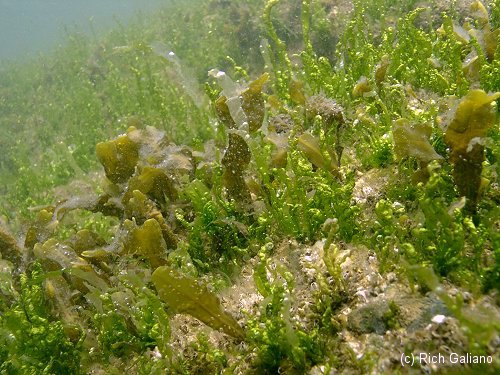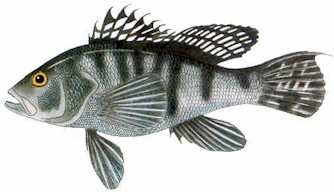Green Algae
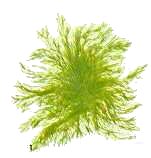 Cladophera 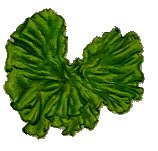 Ulva or Sea Lettuce | 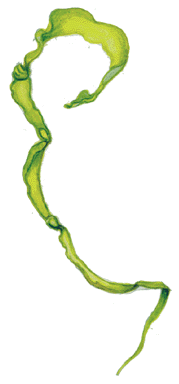 Enteromorpha or Hollow Green Weed |
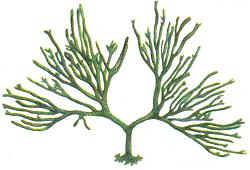
Green algae take many forms, some of which superficially resemble grass and other plants. Cladophora grows in tufts 3"-12" in size. Sea Lettuce - Ulva lactuca - is a green algae that grows in large sheets up to 36" like tissue paper. Small specimens are attached, but large ones are usually found drifting. It is edible and extremely common in protected waters. Enteromorpha algae superficially resembles eelgrass, and like eelgrass may also grow in thick beds.
Codium, also known as Green Fleece or Dead Man's Fingers, ( right ) is a pest species introduced from Europe that is steadily spreading outward along the coast from Long Island. It actually originates in Japan and is spreading around the world.
The fronds are thick and spongy, and the entire "bush" may grow up to 36" although it is usually smaller. These algae is sometimes seen offshore at depths where it could not possibly have grown. My guess is that it was swept out from shallow water in a storm, carrying whatever stone or object it grew on along with it, and settled on the bottom, where it will eventually die in the darkness.
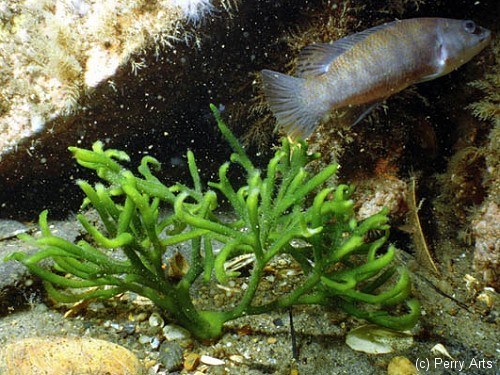
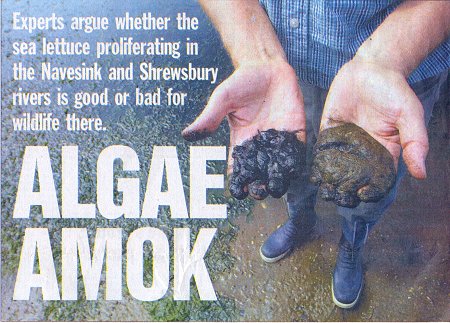
Sea lettuce, a kind of green algae that conservationists say is a critical food supply for some wildfowl, covers large sections of the Navesink River Rumson. Research scientist Clyde L. MacKenzie Jr. (above) shows the difference between Navesink River sediment taken from under a patch of sea lettuce (left), which he said contains only dead, rotting matter; and mud taken from another section (right), which he said is teeming with life. Mackenzie says some of the sea lettuce in local rivers should be removed because it kills everything beneath it, including soft-shell crabs.
By TODD B. BATES
ENVIRONMENTAL WRITER
STAFF PHOTOS: THOMAS P. COSTELLO
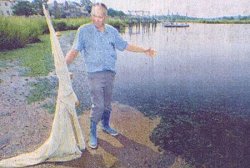
RUMSON - Clyde L. MacKenzie Jr. grabbed two handfuls of sediment in the shallows of the scenic Navesink River off Navesink Avenue. One of the samples, taken from beneath a patch of sea lettuce, was almost black, full of rotting matter, and virtually devoid of life, according to MacKenzie, of the National Marine Fisheries Service on Sandy Hook. The other sample, removed from an area free of sea lettuce, had brown scum on the surface that was "full of live animals, " including tiny worms and shrimp-like creatures, the habitat biologist said.
MacKenzie wants some of the prolific seaweed, which he said has increased in the Navesink and Shrewsbury rivers this year, to be removed. Sea lettuce helped kill soft-shell clams in the rivers in the mid-1990s and has helped prevent them from making a comeback, according to MacKenzie. "It's killed everything along the shore" in calm areas of the two rivers, he said. "It disturbs me." But conservationists said sea lettuce is food for Atlantic brant and other birds, and they'd like to see more research on its use by animals, the impact of harvesting it, and the need to control it.
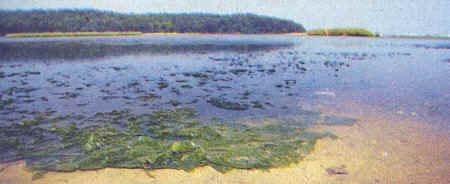
| "It's killed everything along the (river) shore."- Clyde L Mackenzie Jr. of the National Marine Fisheries Service on Sandy Hook. | "It creates a special type of habitat and is a food source for waterfowl, invertebrates, and fish."- Amy Cradic, spokeswoman for the New Jersey Department of Environmental Protection. |
Food for wintering birds
Eric Stiles, vice president of conservation for the New Jersey Audubon Society, said sea lettuce is "an absolutely critical food supp1y" for wintering brant. Stiles said he would need to "understand a lot more" about MacKenzie's proposal before reacting to it. "It depends on the scope and magnitude of what is being proposed, what (are) the primary and secondary ecological impacts beyond even the avian species, and really looking at the science behind the conclusion that it needs to be controlled, " he said.
Amy Cradic, a spokeswoman for the state Department of Environmental Protection, said the DEP has "received no formal proposal for removal" of the plant. "Basically, removing sea lettuce is not an option being considered by the department at this time, " Cradic said. "It creates a special type of habitat and is a food source for waterfowl, invertebrates, and fish."
Ulva lactuca, the Latin name for this species of sea lettuce, has become a problem in North America and Europe over the past 30 years as levels of nutrients have increased in estuaries, MacKenzie has said. And sea lettuce, a bright green form of algae, has overrun shallow areas in the Navesink and Shrewsbury rivers in recent years, according to MacKenzie, 72, of Fair Haven.
Estuaries, where freshwater from rivers meets saltwater from the ocean, are key nurseries for marine life. Sea lettuce flourishes in areas with lots of nitrogen and phosphorus, which. can come from fertilizers, street runoff, and other sources, experts say. Such nutrients fuel the growth of algae. "Up to 30 to 40 years ago, for thousands (of years) there was very little sea lettuce, " MacKenzie said.
Part of the food chain
Sea lettuce affects the food chain, be. ginning With plankton and including killifish, a foundation of the marine food chain, and likely the fish that eat killifish, according to MacKenzie. Sea lettuce kills everything beneath it, MacKenzie said. And nothing grows its surface because it produces small amounts of toxins, repelling plants or animals that might attach to it, such as barnacles, small mollusks, oysters, and other algae, he has said. MacKenzie said he believes that this year's rainfall, which led to lower salt levels in the two rivers, has resulted in a lot more sea lettuce than during last year's drought. Still, "I don't know what drives it, to be honest with you, " he said. "It's just my guess."
MacKenzie said he saw much larger amounts of sea lettuce in the mid-1990s, when the seaweed-covered and killed many soft-shell clams in the Navesink and Shrewsbury rivers in 1994. A heatwave the next year killed the rest. Although he's sure sea lettuce has some benefits, "overall, it does a lot of harm, " MacKenzie said. Using nets to haul sea lettuce out of the water twice a summer and then letting it dry and decay on the shoreline would be one way to control it, according to MacKenzie. There also will be "enough of it to grow back, " he said.
Scott Barnes, a senior naturalist at the New Jersey Audubon Society's Sandy Hook Bird Observatory, said he's seen both Atlantic brant and greater scaup eat sea lettuce. Brant are much smaller than their close cousins, Canada geese, and greater scaup are small diving ducks, according to officials. The area that includes Raritan Bay and the Navesink and Shrewsbury rivers has "arguably the largest concentration of greater scaup on the East Coast, " Barnes said, with 20,000 to 50,000 of them spending their winters there. Thousands of brant also overwinter in the area. Frequently, ducks will pop to the surface with sea lettuce in their mouths, and herring gulls will try to steal the lettuce, Barnes said.
More research advocated
Andrew J. Willner, New York-New Jersey Baykeeper, an affiliate of the Sandy Hook-based American Littoral Society, said "we've been finding that some creatures have sort of adapted" to sea lettuce, including brant. The seaweed is "unsightly and it's not fun to walk through, but with the lack of eelgrass and other kinds of vegetation, perhaps it is taking up some of that niche, " Willner said.
Sea lettuce could be used as a fertilizer, eliminating some of the chemicals people put on their gardens and, lawns, and composting it would be "a great thing, " Willner said. "I would also be very careful, and some research should be done on what animals are using" sea lettuce, he said. "We may want to investigate that a little further to see if there was some reason it should not be harvested."
Beatrice Sena, Fair Haven Borough Council president, began using sea lettuce as a plant fertilizer years ago. This year, she planted tomatoes in a container with decomposing sea lettuce to see how her plants would do without other fertilizers being added, Sena said. "I must tell you, they are extraordinary, " she said. "They're healthy plants. The fruit that I have is blemish-free and quite large and I don't know if it's attributable to the variety of tomato I use, with the disease-resistance factor within the plant. However, I still swear by my sea lettuce, although I didn't add any this year."
Sena said, "I still would love to see benefits from this organic compound, especially if Mr. MacKenzie feels that it's grown to an extent it could be detrimental to the other natural biological life that's there. "I would love for it to be utilized, as long as it was environmentally sound to do so and as long as it was cost-effective to do so, " she said. "I hate to see anything wasted."
Reprinted from the Asbury Park Press
Sunday, Sept 14, 2003
Todd B. Bates: (732) 643-4237 or tbates@app.com

